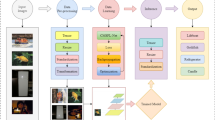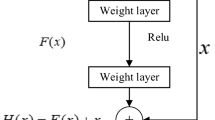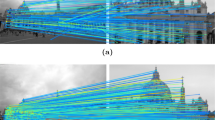Abstract
After the research based on the progressing image classification recognition method of CNN, the paper aims at the problem that the size of feature size of output map of image with different complexity cannot be well solved by the constant value stride. We bring up the idea which based on the variable stride length for constraint parameters to selectively select the size of the stride. It is helpful to improve the efficiency of selective extraction and recognition of important features. Later studies have proved that the deficiency issue of complex image characteristic extraction due to the large stride size could be averted by adopting the variable stride length method based on constraint parameters. In the meantime, the method also avoids low recognition efficiency due to the image complexity is sparse and, also, the stride size of the image is too small. The theoretically calculated results are in good agreement with the experimental results.





Similar content being viewed by others
Explore related subjects
Discover the latest articles and news from researchers in related subjects, suggested using machine learning.References
Bengio Y (2009) Learning deep architectures for AI[J]. foundations and trends in. Mach Learn 2(1):1–127
Boureau YL, Ponce J, Lecun Y (2010) A theor-etical analysis of feature pooling in visual recognition [C]. Proc of International Conference on Machine Learning, p 111–118,
Chan T-H, Jia K, Gao S et al (2015) PCANet:a simple deep learning baseline for image classification[J]. IEEE Trans Image Process 24(12):5017–5032
Dalal N, Triggs B (2005) Histograms of oriented gradients for human detection[C]. Computer Vision and Pattern Recognition, 2005. IEEE Computer Society Conference on Piscataway, NJ: IEEE, p 886–893
Fei-Fei L, Karpathy A, Johnson J (2016) CS231n:Convolutional neural networks for visual recognition. Stanford
Goodfellow I, Bengio Y, Courville A (2016) Deeplearning. Book in preparation for MIT Press
Han FY (2010) Analysis of modern multimedia technology features and key technologies. JCNU(NS) 29(3):129–131
Hinton GE, Salakhutdinov RR (2006) Reducing the dimensionality of data with neural networks. Science 313(5786):504–507
Hinton GE, Osindero S, Teh YW (2006) A fast learning algorithm for deep belief nets [J]. Neural Comput 18(7):1527–1554
Kalchbrenner N, Grefenstette E, Blunsom P (2014) A con-volutional neural network for modeling sentences. arXiv preprint arXiv:1404.2188
Koutník J, Greff K, Gomez F, et al (2014) A Cl-ockwork RNN [J]. Computer Science:1863–1871
Krizhevsky A, Hinton G (2009) Learning multiple layers of features from tiny images
Krizhevsky A, Sutskever I, Hinton GE (2012) Imagenet classification with deep convolutional neural networks [C] . Proc of the Conf of Advances in Neural Information Processing Systems. Rostrevor, Ireland: Curran Associates, Inc, p 1097–1105
Le QV, Ranzato M, Monga R, et al (2013) Building high-level features using large scale unsupervised learning [C]. Proc of the IEEE Int Conf on Acoustics, Speech and Signal Processing. Piscataway, NJ: IEEE, p 8595–8598
Lecun Y, Boser B, Denker JS et al (2014) Backpropagation applied to handwritten zip code recognition [J]. Neural Comput 1(4):541–551
Lee H, Grosse R, Ranganath R, et al (2009) Convolutional deep belief networks for scalable unsupervised learning of hierarchical representations [C]. Proc of the 25th Annual Int Conf on Machine Learning. Piscataway, NJ: IEEE, p 609–616
Dan Meng (2017) Research on image classification method based on deep learning. East China Normal University Press, p 5–15
Qian Y (2012) An alternative algorithm for finding the maximum value of a function--golden section search method. JEIJP 28(12):140–142
Russakovsky O, Deng J, Su H et al (2015) Imagenet large scale visual recognition challenge [J]. Int J Comput Vis 115(3):211–252
Wang B (2015) Research on image classification and image retrieval based on visual features and machine learning [D]. XiDian University, p 1–4
Yang J, Yu K, Gong Y, et al (2009) Linear spatial pyramid matching using sparse coding for image classification [J]. 1794–1801
Ye XY, Qin J (2006) The characteristics of shallow learning and deep learning are shown in the table. Educational technology guide. No.1, p 19–21
Yu K (2013) Large-scale deep learning at Baidu [C]. Proc of ACM International Conferenceon Information & Knowledge Management. p 2211–2212
Zhang C, Li X, Yan J, et al (2014) Sufficient statistics feature mapping over deep Boltzmann machine for detection[C]. International Conference on Pattern Recoginition (ICPR), p 827–832
Zhang J, Wang H, Yang G, Xiao H (2018) Review of deep learning. ARC 35(7):1–2
Jun Zhu (2015) Image classfication based on deep learning models. Ningbo University. p 6–7
Acknowledgements
The Project was supported by the Natural Science Foundation of Liaoning Province (Grant No. 20170540131), Nature Science Foundation of Heilongjiang Province (Grant No.C201437), Natural Science Foundation of Heilongjiang Province (Grant No. QC2018082) and Basic Scientific Research Funds of Heilongjing Provincial Higher Education lnstitutions (Grant No. 2017-KYYWF-0140). And we wish to thank the anonymous reviewers who helped to improve the quality of the paper.
Author information
Authors and Affiliations
Corresponding author
Additional information
Publisher’s Note
Springer Nature remains neutral with regard to jurisdictional claims in published maps and institutional affiliations.
Rights and permissions
About this article
Cite this article
Guo, C., Liu, Yl. & Jiao, X. Study on the influence of variable stride scale change on image recognition in CNN. Multimed Tools Appl 78, 30027–30037 (2019). https://doi.org/10.1007/s11042-018-6861-0
Received:
Revised:
Accepted:
Published:
Issue Date:
DOI: https://doi.org/10.1007/s11042-018-6861-0




